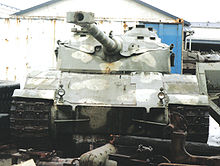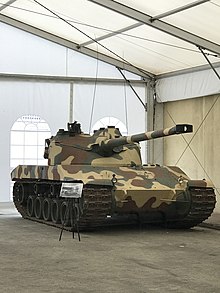Batignolles-Châtillon Char 25T

|

|
|
|
Prototype in the Musée des Blindés ( Saumur ) before and after the restoration
|
||
The Batignolles-Châtillon Char 25T was a French tank project from the 1950s. The project was very progressive for the time (very flat tub, hydraulic suspension, weighing tower), but never reached series production; only two prototypes were built.
At the beginning of the 1950s, the development of HEAT ammunition continued, which made it possible to penetrate even thick armor steel plates. This led to the realization that the armor of tanks can no longer offer reliable protection (at this point there was no composite and reactive armor ; these were only developed in the 1960s). From this, the military concluded that the focus of future tanks would have to be on mobility rather than on armor. The Char 25T was therefore developed according to the principle "as light as possible".
A special feature of the Char 25T is the weighing tower without a cannon mantlet. The weighing tower concept was considered very advanced in the 1950s as it made it easier to use a car loader for the cannon and, crucial for the Char 25T, enabled weight savings. The fundamental disadvantage of weighing towers, namely the small vertical angle of inclination of the on-board cannon, was accepted with the Char 25T. A 90 mm DCA 45 cannon with an autoloader was used as the main armament. Considerations to install a 75-mm cannon in order to further save weight were rejected due to the inadequate performance of such a weapon. With a length of 5.67 m, width of 3.16 m and a height of 2.37 m, the weight of the Char 25T could be kept below 25 t. In combination with a SOFAM-3M.27.1.01 engine with 500 hp, the Char 25T reached a top speed of 65 km / h. A 4-man crew was provided for the crew, although the use of a radio operator was relatively unusual. Most of the tank projects of that time did without an extra radio operator.
In the competition for the future tank of the French army, the Char 25T was defeated by the much more conventional AMX-30 . The main reason for this was that the innovative design of the Char 25T was very maintenance-intensive, especially the hydraulic suspension. Furthermore, it would have been difficult to install extensive NBC protection in the Char 25T , which became increasingly important during the Cold War. Although the Char 25T never got beyond the prototype stage, some technologies were later used in other vehicles.
